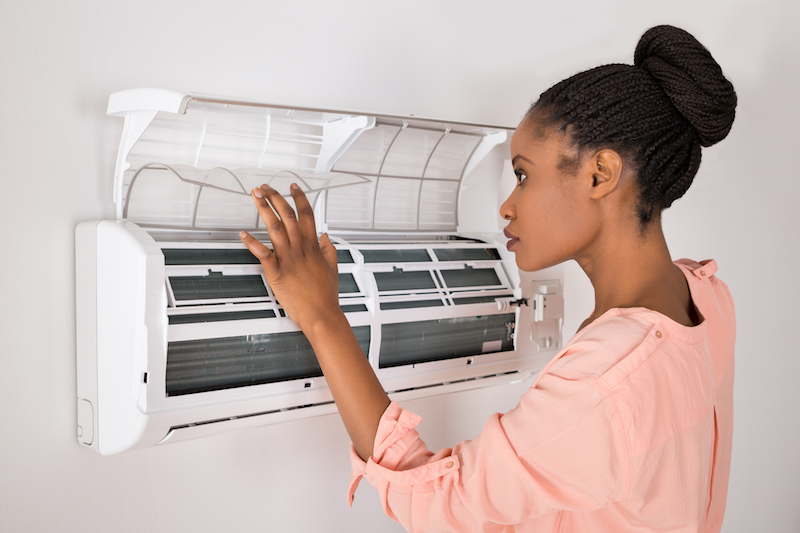
You shouldn’t be forced to give up comfort or empty your wallet to keep your house at a pleasant temp during hot days.
But what is the right temperature, exactly? We discuss ideas from energy professionals so you can find the best temperature for your family.
Here’s what we advise for the most energy-efficient setting for air conditioning in Manassas.
Recommended Thermostat Settings for Summer
Most families find placing the thermostat at 72-73 degrees is ideal. However, if there’s a big difference between your indoor and exterior temps, your cooling expenses will be bigger.
These are our recommendations based on the U.S. Department of Energy (DOE) and ENERGY STAR®.
While at home: 78 degrees. While that sounds warm, there are methods you can keep your home pleasant without having the air conditioning going constantly.
Keeping windows and window treatments closed during the day keeps chilled air where it needs to be—inside. Some window solutions, such as honeycomb shades or plantation shutters, are created to deliver extra insulation and enhanced energy efficiency.
If you have ceiling fans in your house, the DOE says you can raise thermostat temperatures about 4 degrees warmer without compromising comfort. That’s because they freshen through a windchill effect. As they cool people, not rooms, shut them off when you move from a room.
If 78 degrees still appears too warm on the surface, try conducting an experiment for a week or so. Start by raising your setting to 78 degrees while you’re at your residence. Then, progressively turn it down while adhering to the suggestions above. You may be shocked at how cool you feel at a warmer temperature setting.
While away: 88 degrees. There’s no need to keep the air conditioning going all day while your home is vacant. Turning the temperature 7–10 degrees hotter can save you anywhere from 5–15% on your air conditioning expenses, according to the DOE.
When you arrive home, don’t be tempted to switch your thermostat colder than 78 to cool your residence faster. This isn’t useful and often leads to a bigger cooling cost.
A programmable thermostat is a good way to keep your temp under control, but you have to set programs. If you don’t utilize programs, you might forget to move the set temperature when you leave.
If you need a hassle-free remedy, consider getting a smart thermostat. This thermostat connects with your phone, so it knows when you’re at your house and when you’re out. Then it intuitively modifies temperature settings for maximum savings. How much exactly? About $180 annually on heating and cooling, according to ENERGY STAR.
Another benefit of using a smart thermostat? You can use your phone to watch and change temperature settings from just about anywhere.
While sleeping: Around 70 degrees. While ENERGY STAR suggests 82 degrees, that may be too uncomfortable for most families. Many people sleep better when their sleeping space is chilly, so that’s why the National Sleep Foundation advises 60–67 degrees. But that might be too cool, depending on your clothing and blanket preference.
We recommend using a comparable test over a week, moving your temperature higher and slowly decreasing it to select the right temperature for your residence. On cool nights, you may find keeping windows open at night and running a ceiling fan is a preferable option than using the air conditioner.
More Ways to Conserve Energy During Hot Weather
There are extra ways you can save money on AC bills throughout hot weather.
- Install an energy-efficient AC system. Central air conditioners only last about 12–15 years and lose efficiency as they age. An updated air conditioner can keep your residence comfier while keeping electricity expenses down.
- Set annual air conditioner maintenance. Regular air conditioner maintenance keeps your equipment working like it should and could help it run at better efficiency. It might also help extend its life expectancy, since it helps technicians to pinpoint small issues before they create a major meltdown.
- Change air filters regularly. Follow manufacturer instructions for switching your air filter. A clogged filter can result in your system short cycling, or run too much, and raise your cooling.
- Inspect attic insulation levels. Just about 90% of houses in the USA don’t have enough insulation, according to the Insulation Institute. Most southern climates require 13–14” of attic insulation, while northern climates should have 16–18”.
- Have your ductwork examined. Ductwork that has come apart over time can leak cold air into your attic, walls or crawl space. This can create big comfort troubles in your house, like hot and cold spots.
- Seal openings, doors and windows. Keep humid air in its place by sealing holes. You can also caulk or weather strip doors to trap more cold air indoors.
Save More Energy This Summer with Air-Right Energy Design
If you need to use less energy during warm weather, our Air-Right Energy Design experts can provide assistance. Give us a call at 703-260-9467 or contact us online for extra info about our energy-saving cooling options.






